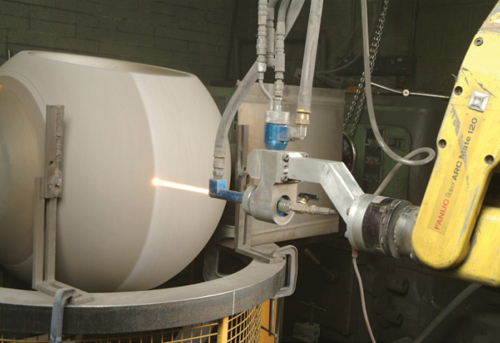
Fossil fuel power stations have rotating machinery to convert the heat energy of combustion into mechanical energy, which then operates an electrical generator. The prime mover may be a steam turbine, a gas turbine or—in small plants—a reciprocating internal combustion engine. All plants use the energy extracted from expanding gas - steam or combustion gases.
A major Texas, U.S.-based power company ran a boiler made by one of the largest global companies in this sector. However, it was experiencing problems with the supercritical steam drain and vent lines in one of its power stations. To resolve the issue, Kennametal Stellite was engaged by Quebec-based Velan, a world leader in valve design and engineering and a specialist in valves designed to work in ‘severe service’ – i.e., with extreme temperatures, high pressures, abrasive, corrosive and acidic environments.
Currently in the power station, metal-seated ball valves (MSBVs) are being used on the drain and vent lines to extract large quantities of condensate during plant start-up, in order to rapidly obtain dry superheated steam. MSBVs must remain steam-tight to prevent energy loss and maximize plant efficiency.
There was an issue with this particular fossil-fuel power station, because it runs continuously from May to October, when there is typically a higher power demand to run air-conditioning systems during the hottest part of the year. However, during November to April, the plant only runs when the demand calls for more power during peak usage times. So, every time the plant shuts down or starts up, MSBVs are operated and exposed to supercritical steam operating conditions, causing additional corrosion problems. There is a considerable risk of thermal shock, as the valves are opened quickly and heat up rapidly. Temperatures can approach 1400°F, but are usually around 1200°F for this application.
The MSBVs in use entailed a floating ball design with a fixed seat, manufactured from forged Inconel 718 PH and coated with a HVOF 80% Cr3C2 + 20% NiCr coating. This coating failed after one year and after less than 500 mechanical cycles in service on balls exposed to supercritical steam, with deterioration extending to regions where there is no contact between ball and seats. A visual examination of damaged components revealed minor frictional wear and typical stress/fatigue pattern.
Testing revealed that the dominant failure mechanism was coating embrittlement due to chrome carbide precipitation in-service across coating binder. As a result, some brand new samples were produced with three new Kennametal Stellite coatings, and a range of tests was performed to assess their behaviour for this specific application.
Once the cause was known, further tests suggested that a spray and-fuse NiWCrBSi coating would be more suitable to support high bearing load when facing thermal shock. This coating is less sensitive to ageing at high temperatures and therefore more durable under these very specific conditions. The spray and fuse method is similar to hardfacing, whereby an oxyacetylene flame is used to heat and deposit a nickel-based alloy onto a substrate. The flame is then used to melt or fuse the material onto the surface. It is similar to welding, except that spray and fuse acts more like a braze than a weld and does not dilute with the base metal, thus avoiding cracking. Spray and fuse is often used general machine component repair. Kennametal Stellite also produced an improved high velocity oxygen fuel (HVOF) coating, produced from a mixed (W,Cr)C and WC carbides in a nickel matrix. The material costs are significantly lower for S/F coating versus the HVOF 80Cr3C2/20NiCr coating that failed.
HVOF thermal spray coatings are produced by first mixing a fuel gas and oxygen within a chamber. The resulting mixture exits the chamber through the nozzle and ignites. The powder feedstock is then fed via carrier gas, axially, into the ignited gases and is propelled uniformly to the workpiece. The HVOF process can create extremely dense coatings with bond strengths in excess of 10,000 PSI. It can also produce very low surface roughness. This frequently results in easier and faster finishing.While it showed similar ductility compared to the original HVOF Cr3C2-NiCr coating, the new coating consistently provided longer in-service life in service under 540°C (1,000°F). Incorporating these new custom-made coating technologies, new valves were installed in the plant, and have worked flawlessly for the past year. Now the coatings should last many years and thousands of cycles. As a result, Velan’s MSBV line for the power industry now features two coatings: one designed for regular service – HVOF (W,Cr)C-Ni — and another specially designed for applications involving severe thermal shocks – S&F NiWCrBSi.
About Kennametal Stellite Kennametal Stellite hardfacing alloys division is a global provider of advanced, metal-based wear solutions across a wide range of industries. The hardfacing alloys division manufactures possibly the widest range of wear-resistant rods, wires and powders, operating three manufacturing plants based in Swindon (UK), Goshen (U.S.) and Shanghai (China).
For more information, please visit www.stellite.com.




